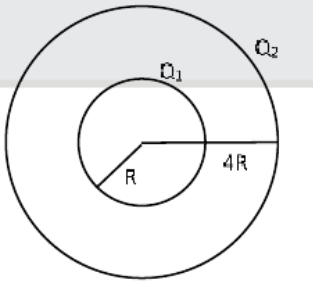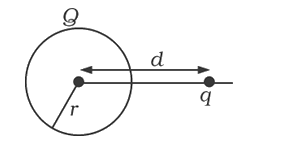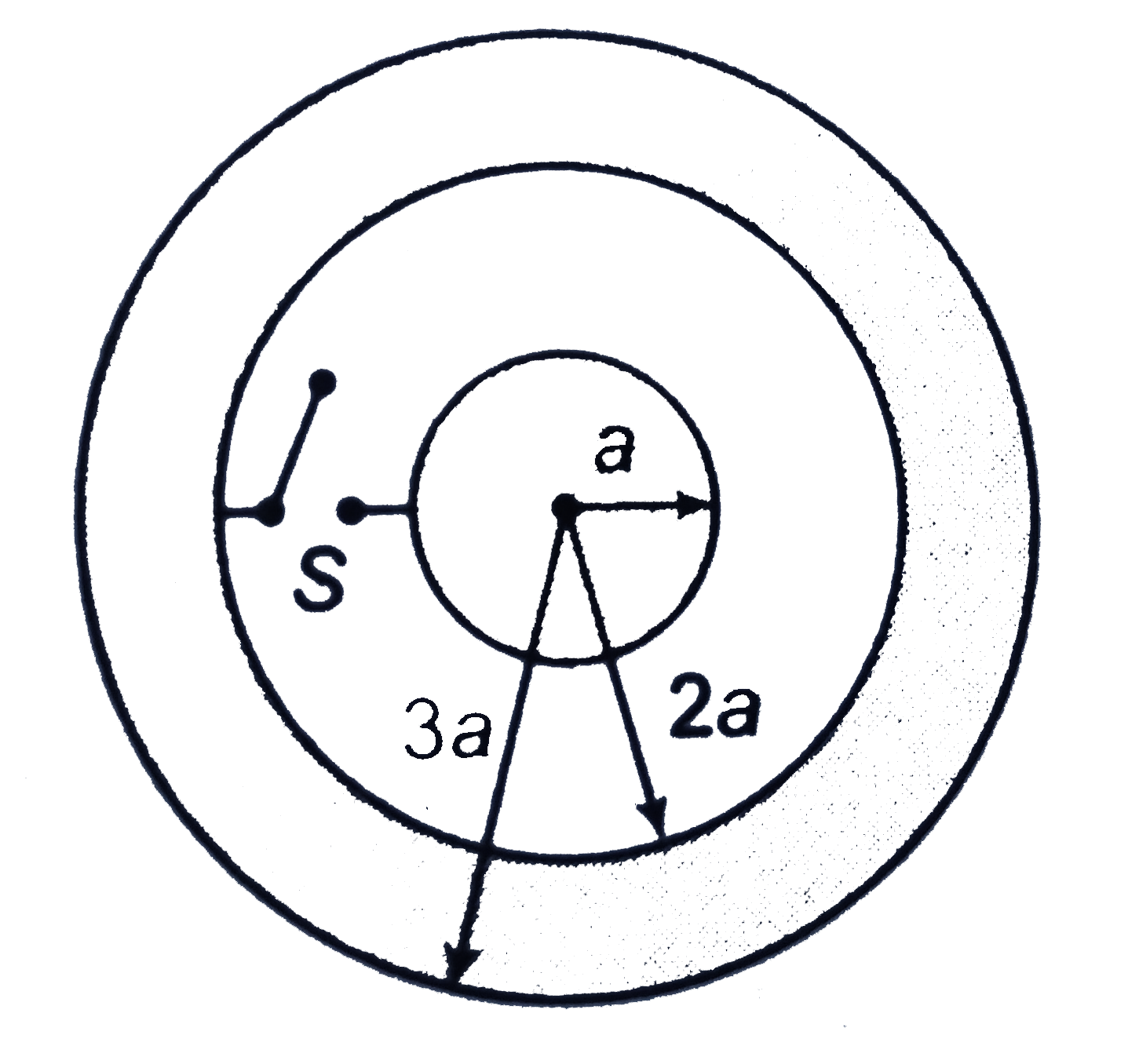A solid conducting sphere, having a charge Q, is surrounded by an unchanged conducting hollow spherical shell. Let the potential difference between the surface of the solid sphere and that of the outer surface of the hollow shell be V. If the shell is now given a change of −4Q, the new potential difference between the same tow surface is :
−2V
2V
4V
V
The correct Answer is:C
To solve the problem, we need to analyze the situation step by step.
Step 1: Understand the Initial Setup
We have a solid conducting sphere with charge Q and a surrounding conducting hollow spherical shell that is initially uncharged. The potential difference V is defined between the surface of the solid sphere and the outer surface of the hollow shell.
Step 2: Determine the Potential of the Solid Sphere
The potential VA at the surface of the solid sphere (radius rA) is given by:
VA=QrA
This is because the potential inside a conductor is constant and equal to the potential on its surface.
Step 3: Determine the Potential of the Hollow Shell
Since the hollow shell is initially uncharged, it will have no contribution to the potential at its outer surface. The potential VB at the outer surface of the hollow shell (radius rB) is influenced by the charge Q of the inner sphere:
VB=QrB
However, since the shell is uncharged, we consider the potential due to the inner sphere only.
Step 4: Calculate the Initial Potential Difference
The potential difference V between the solid sphere and the hollow shell is:
V=VA−VB=QrA−0=QrA
Step 5: Analyze the Change in Charge of the Hollow Shell
Now, the hollow shell is given a charge of −4Q. The new charge on the shell does not affect the potential difference between the two surfaces because the potential difference depends only on the charge of the inner sphere.
Step 6: Determine the New Potential of the Hollow Shell
After the shell is charged with −4Q, the potential VB at the outer surface of the shell is still influenced by the charge Q of the inner sphere. The potential due to the charge −4Q on the shell does not affect the potential difference calculation between the two surfaces.
Step 7: Conclusion
Thus, the new potential difference between the surface of the solid sphere and the outer surface of the hollow shell remains:
V=QrA−0=QrA
This means that the potential difference remains unchanged despite the charge on the hollow shell.
Final Answer
The new potential difference between the surface of the solid sphere and that of the outer surface of the hollow shell is still V.
---
We have a solid conducting sphere with charge Q and a surrounding conducting hollow spherical shell that is initially uncharged. The potential difference V is defined between the surface of the solid sphere and the outer surface of the hollow shell.
The potential VA at the surface of the solid sphere (radius rA) is given by:
VA=QrA
This is because the potential inside a conductor is constant and equal to the potential on its surface.
Since the hollow shell is initially uncharged, it will have no contribution to the potential at its outer surface. The potential VB at the outer surface of the hollow shell (radius rB) is influenced by the charge Q of the inner sphere:
VB=QrB
However, since the shell is uncharged, we consider the potential due to the inner sphere only.
The potential difference V between the solid sphere and the hollow shell is:
V=VA−VB=QrA−0=QrA
Now, the hollow shell is given a charge of −4Q. The new charge on the shell does not affect the potential difference between the two surfaces because the potential difference depends only on the charge of the inner sphere.
After the shell is charged with −4Q, the potential VB at the outer surface of the shell is still influenced by the charge Q of the inner sphere. The potential due to the charge −4Q on the shell does not affect the potential difference calculation between the two surfaces.
Thus, the new potential difference between the surface of the solid sphere and the outer surface of the hollow shell remains:
V=QrA−0=QrA
This means that the potential difference remains unchanged despite the charge on the hollow shell.
The new potential difference between the surface of the solid sphere and that of the outer surface of the hollow shell is still V.
Topper's Solved these Questions
Similar Questions
A conducting shell S1 having a charge Q is surrounded by an uncharged concentric conducting spherical shell S2.
Let the potential difference between S1 and that S2 be V. If the shell S2 is now given a charge −3Q, the new potential difference between the same two shells is
View SolutionA conducting shell S1 having a charge Q is surrounded by an uncharged concentric conducting spherical shell S2. Let the potential difference between S1 and that S2 be V. If the shell S2 is now given a charge −3Q, the new potential difference between the same two shells is
View SolutionA conducting sphere is enclosed by a hollow conducting shell. Initially the inner sphere has a charge Q while the outer one is uncharged. The potential difference between the two spherical surface is found to be V. later on the outer shell is given a charge -4Q. The new potential difference between the two surfaces is : (A) V (B) −V (C) −2V (D) 2V
View SolutionIn the given figure there are two concentric shells find potential difference between spheres.

View SolutionA solid conducting sphere of radius r is having a charge of Q and point charge q is a distance d from the centre of sphere as shown. The electric potential at the centre of the solid sphere is :

View SolutionA solid conducting sphere of radius a having a charge q is surrounded by a concentric conducting spherical shell of inner radius 2a and outer radius 3a as shown in figure. Find the amount of heat porduced when switch is closed (k=14πε0)

View SolutionA solid conducting sphere of radius a having a charge q is surrounded by a concentric conducting spherical shell of inner radius 2a and outer radius 3a as shown in figure. Find the amount of heat porduced when switch is closed (k=14πε0)

View SolutionA solid conducting sphere of radius a having a charge q is surrounded by a concentric conducting spherical shell of inner radius 2a and outer radius 3a as shown in figure. Find the amount of heat porduced when switch is closed (k=14πε0)

View SolutionA spherical conductor having charge q and radius r is placed at the centre of a spherical shell of radius R and having charge Q (R > r). The potential difference between the two is
View SolutionA conducting sphere carrying charge Q is surrounded by a spherical conducting shell.
a. What is the net charge on the inner surface of the shell?
b. Another charge q is placed outside the shell. Now, what is the net charge on the inner surface of the shell?
c. If q is moved to a position between the shell and the sphere, what is the net charge on the inner surface of the shell?
d. Are your answer valid if the sphere and shell are not concentric?
View Solution
